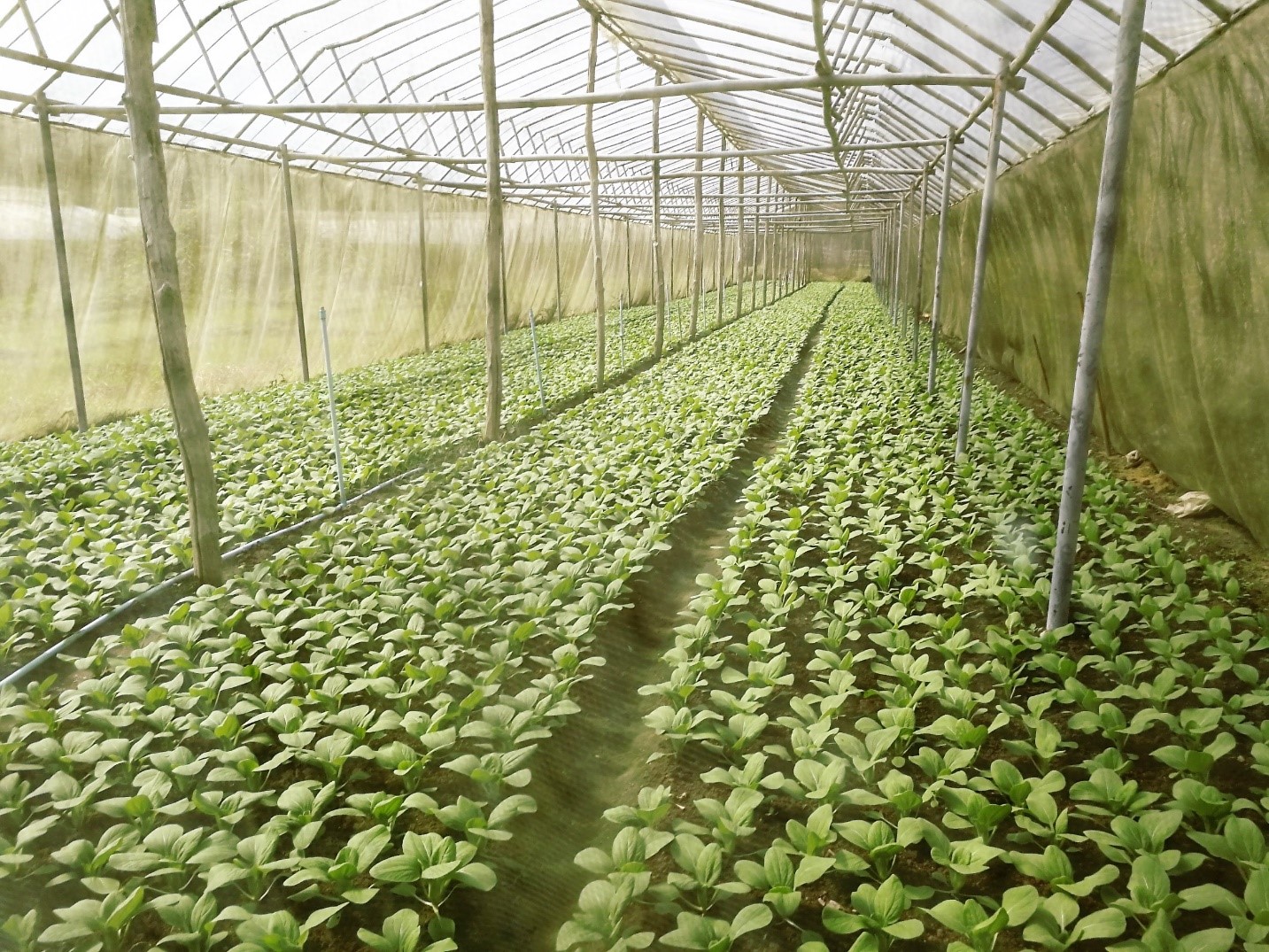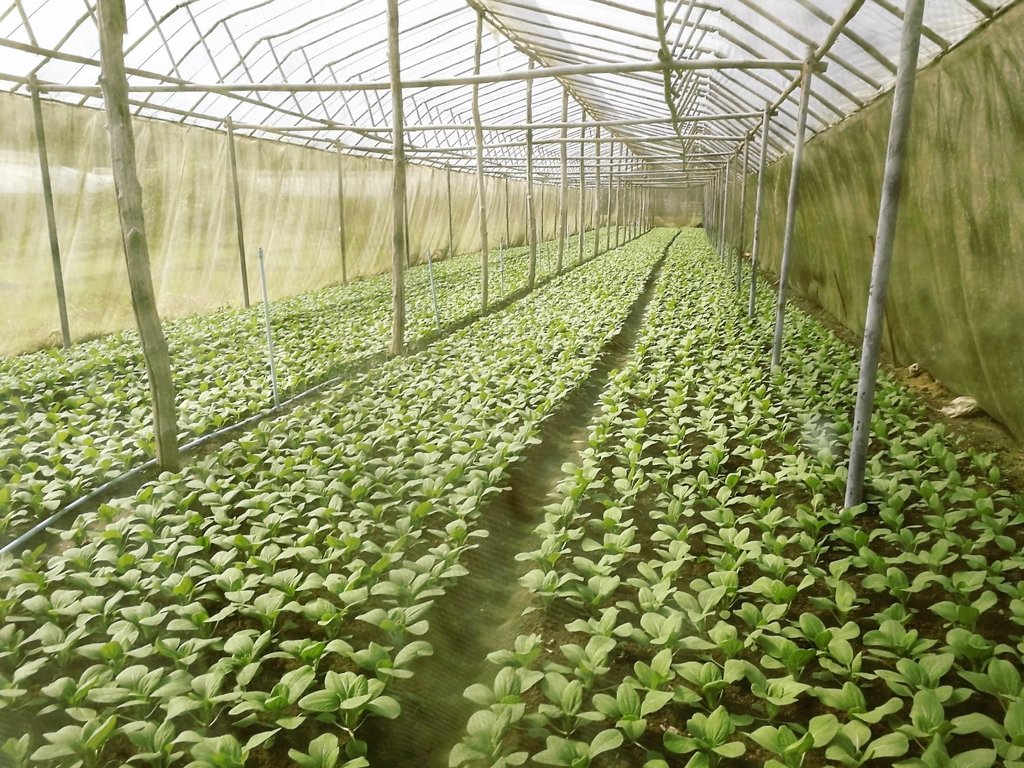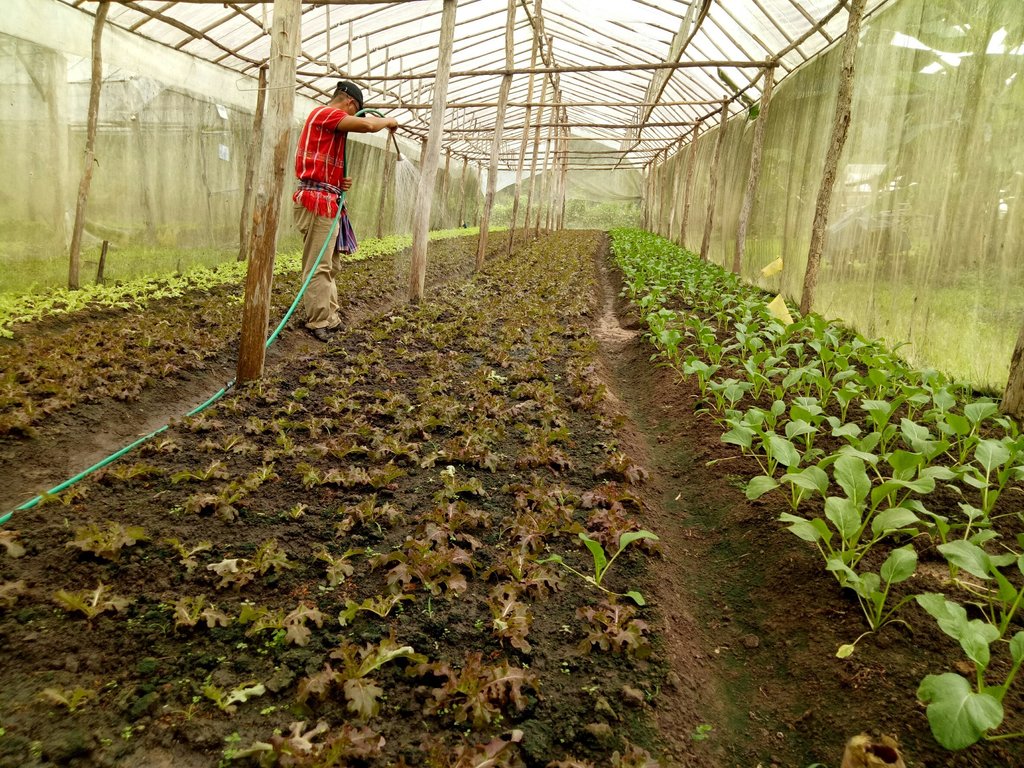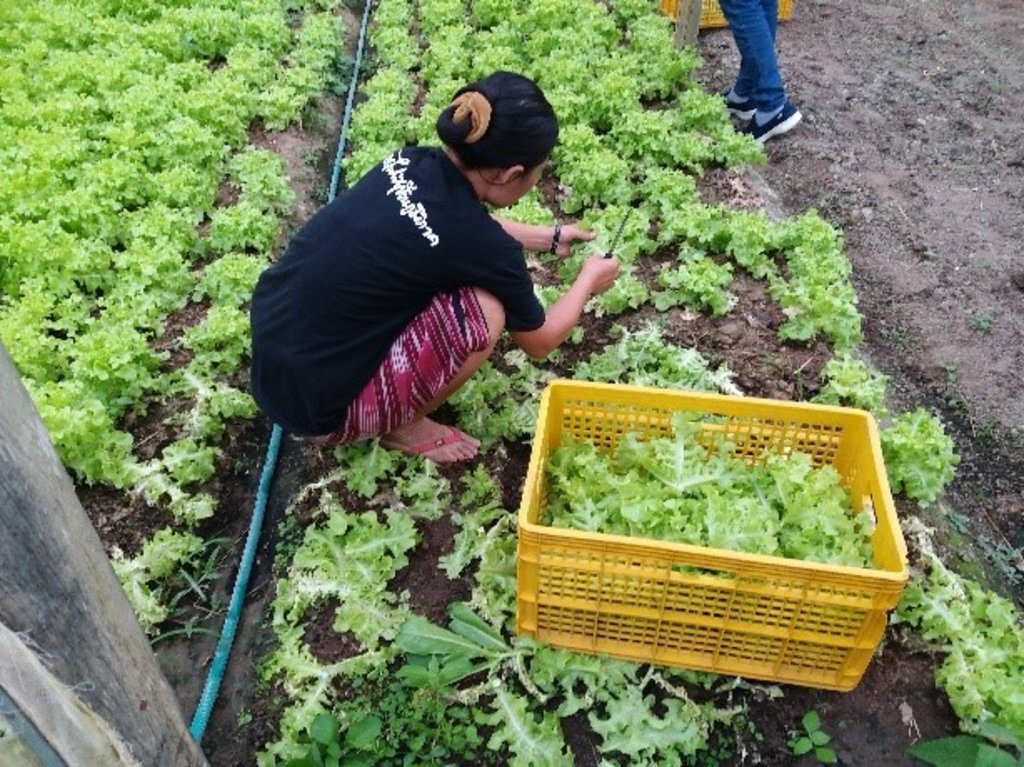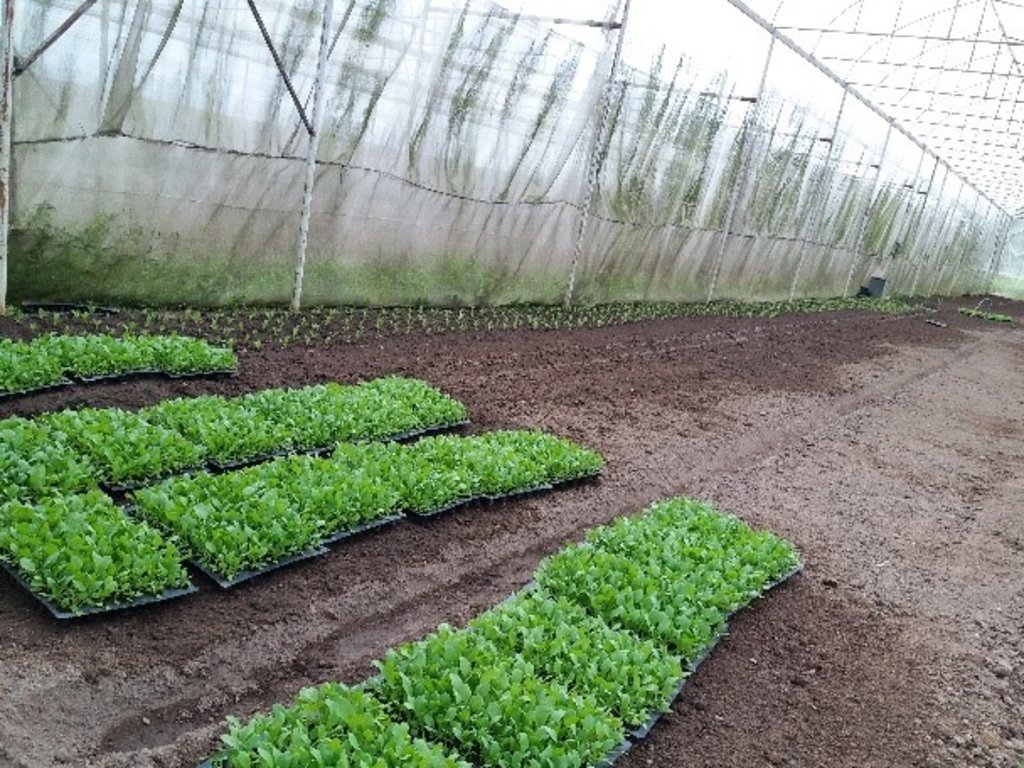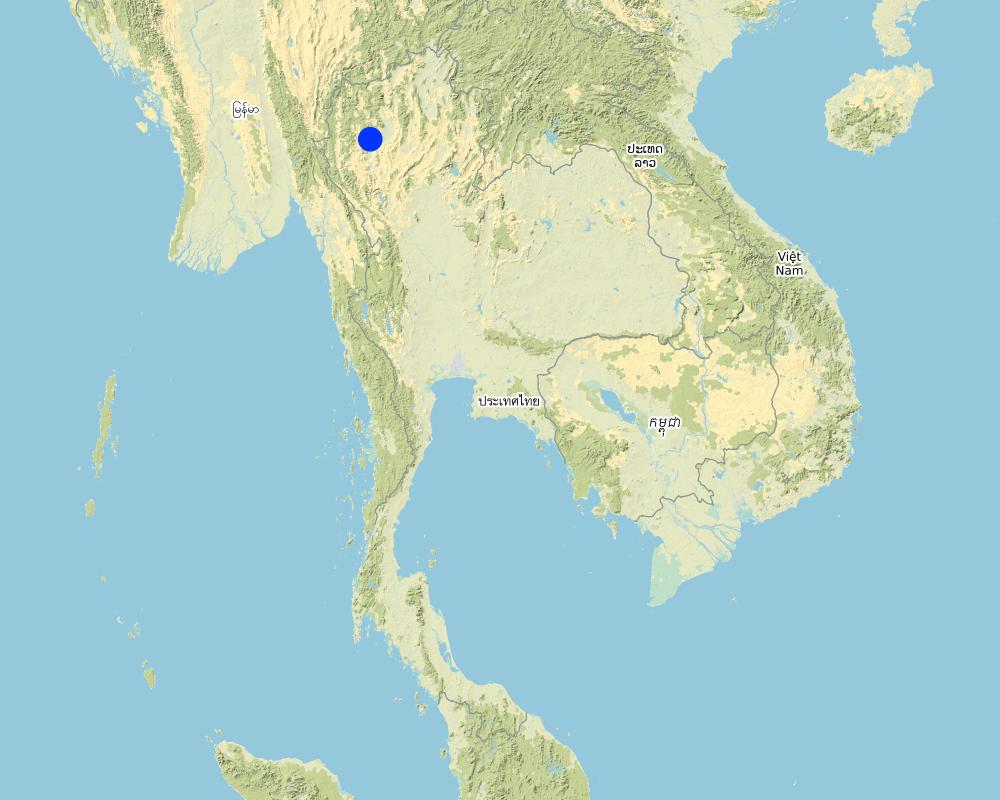Integrated Soil Management for Organic Vegetables on the Highland Watershed in the Northern Region [Thailand]
- Creation:
- Update:
- Compiler: Pitayakon Limtong
- Editor: –
- Reviewers: Rima Mekdaschi Studer, William Critchley
Organic vegetables in the Royal Project
technologies_4283 - Thailand
View sections
Expand all Collapse all1. General information
1.2 Contact details of resource persons and institutions involved in the assessment and documentation of the Technology
Key resource person(s)
co-compiler:
Wattanaprapat Kamalapa
Land Development Department
Thailand
land user:
Phojanabandit Watcharin
Headman of village
Thailand
local extension officer:
Kerephuwadon Boontre
Inthanon Royal Agricultural Station, the Royal Project
Thailand
local LDD officer:
Intha Charun
Royal Project Land Development Center, Land Development Office Region 6, Land Development Department.
Thailand
Name of the institution(s) which facilitated the documentation/ evaluation of the Technology (if relevant)
Land Development Department LDD (Land Development Department LDD) - Thailand1.3 Conditions regarding the use of data documented through WOCAT
The compiler and key resource person(s) accept the conditions regarding the use of data documented through WOCAT:
Yes
1.4 Declaration on sustainability of the described Technology
Is the Technology described here problematic with regard to land degradation, so that it cannot be declared a sustainable land management technology?
No
Comments:
Organic vegetable production is a technology that prevents and restores land degradation due to soil management emphasized in using organic and natural materials to improve soil fertility and productivity, especially in terms of soil organic matter.
2. Description of the SLM Technology
2.1 Short description of the Technology
Definition of the Technology:
Organic vegetable cultivation on the highland area of the northern region of Thailand has been encouraged by local officers in order to produce safe food on degraded land through building up soil fertility and soil organic matter.
2.2 Detailed description of the Technology
Description:
This case study is of organic vegetable cultivation at Ban Muang Ang Village which is located in Ban Luang Sub-district, Chom Thong District, Chiang Mai Province, covering approx. 25,881 Rai (6.25 rai = 1 ha; 625 rai = 1 sq km). The topography is a complex mountainous area within the Doi Inthanon National Park, at an elevation of 600-800 m asl. The climate is quite cool and humid with average temperature throughout the year being 20⁰C. The average annual rainfall is 2,000-2,100 mm. Most of the population belong to the Pakhayo hilltribe, living in 219 households, with total population of 588 persons (308 males, 280 females). The main purpose of promoting growing organic vegetables in greenhouses is to change their way of life from forest encroachment/ shifting cultivation in the upper watershed, to improving the ecosystem services and environment with better health and higher incomes for villagers.
Since 2002, the government and the Royal Project Foundation have had a policy to change land use to organic farming. At the early stage, yields of organic vegetables were not good. In the year 2010, the Inthanon Royal Agricultural Station brought a number of these land users to visit the Mae Tho Royal Project Development Center in Bo Sali Sub-district, Hot District, Chiang Mai Province. They obtained knowledge about organic cultivation in simple greenhouses made from bamboo poles, covered with plastic sheets and nylon nets. Local officers of the Inthanon Royal Agricultural Station supported with education, offered suggestions and recommended practices, as well as finding markets to sell the organic products; that became the model. It took only 25-30 days for a crop, and they could harvest about 200 kg of vegetables per greenhouse. They could produce 11 crops of vegetables in one year, which means that they could earn 10 times more income than before. At present, Muang Ang Village there are 153 members operating in 270 greenhouses which is the largest organic vegetable production area in the Inthanon Royal Project.
The production of organic vegetables in this area is outstanding. This network has received certification from the Department of Agriculture (DOA) and the Office of Organic Agriculture Certification Thailand (ACT Organic). Farmers or farming enterprises certified by this system are entitled to apply the logos and certification card of ACT Organic and IFOAM Accredited brand on their products. Moreover, the Agri-Food & Veterinary Authority of Singapore (AVA) has approved the production processes. Every production step has been approved through the standard regulation of each agency with tracking to the source of production inputs such as fertilizers, disease, weed and pest control measures, cultivation practices, etc. Now they have nine types of vegetables that constitute the main production: Choy, Baby Emperor, Cos Salad, Green Oak, Red Oak, Fille Iceberg, String Bean, Kale Hong Kong and Baby Carrot.
2.3 Photos of the Technology
General remarks regarding photos:
The simple nursery is 6 meters wide, 30 meters long, and 5 meters high. Organic vegetable seed is supported from the Royal Project with ready to planting into the plot.
2.4 Videos of the Technology
Date:
13/09/2018
Location:
Moo 9, Ban Mung Aung Village, Ban Luang Sub-district, Chom Thong District, Chiang Mai Province
Name of videographer:
Ms. Kamalapa Wattanaprapat
2.5 Country/ region/ locations where the Technology has been applied and which are covered by this assessment
Country:
Thailand
Region/ State/ Province:
Ban Luang Sub-district, Chom Thong District, Chiang Mai Province
Further specification of location:
Inthanon Royal Agricultural Station
Specify the spread of the Technology:
- applied at specific points/ concentrated on a small area
Comments:
This activity is the integrated implementation project of the Royal Project in collaboration with other government agencies.
Map
×2.6 Date of implementation
Indicate year of implementation:
2002
If precise year is not known, indicate approximate date:
- 10-50 years ago
2.7 Introduction of the Technology
Specify how the Technology was introduced:
- through projects/ external interventions
Comments (type of project, etc.):
All knowledge and technology is supported by the Royal Project collaboration with Land Development Department and other government and private agencies.
3. Classification of the SLM Technology
3.1 Main purpose(s) of the Technology
- conserve ecosystem
- preserve/ improve biodiversity
- create beneficial economic impact
3.2 Current land use type(s) where the Technology is applied

Cropland
- Annual cropping
Specify:
Vegetables: Cantonese, Baby Emperor, CosSalad, Oak leaf Green, Oak leaf Red, Guest Bean, Filler Iceberg, Kale Hong Kong and Baby Carrot.

Waterways, waterbodies, wetlands
Main products/ services:
Irrigation water from a storage tank at the upper part, through PVC pipes to the area cultivated to the organic vegetables.
Comments:
In the past, villagers had encroached on forest areas and deforestation in highland for shifting cultivation, and also expand cultivation area into steep slope. Resulting in the destruction of forest areas and accelerated soil degradation. Villagers have low incomes: not enough to survive. But due to the grace of His Majesty King Bhumibol Adulyadej, King Rama 9 set up the Royal Project to distribute knowledge and education to all farmers in this area, and assist them to have better occupation and living standards.
3.3 Has land use changed due to the implementation of the Technology?
Comments:
The Royal Project has promoted the production of organic vegetables. Farmers therefore have changed from shifting cultivation to organic agriculture with sustainable soil management. As well as returning from forest areas and conserving soil, water and forest resources, maintaining ecological balance, this all makes villagers lives better. According to the cultivation schedule provided by the Royal Project, this area can cultivated throughout the year due to the development of irrigation systems from the storage tank in the upper part and supply to each plot of this targeted area.
3.4 Water supply
other (e.g. post-flooding):
- water from watershed area
Comments:
Water resources are obtained from watercourses in the watershed, with a small dam which collects water in a reservoir. A PVC pipe is connected from the reservoir to individual plots and this irrigation system allows allocation to every farmer by the water management group.
3.5 SLM group to which the Technology belongs
- rotational systems (crop rotation, fallows, shifting cultivation)
- integrated pest and disease management (incl. organic agriculture)
- irrigation management (incl. water supply, drainage)
3.6 SLM measures comprising the Technology

agronomic measures
- A2: Organic matter/ soil fertility

management measures
- M2: Change of management/ intensity level
Comments:
-
3.7 Main types of land degradation addressed by the Technology

soil erosion by water
- Wt: loss of topsoil/ surface erosion

chemical soil deterioration
- Cp: soil pollution

biological degradation
- Bl: loss of soil life
- Bp: increase of pests/ diseases, loss of predators
Comments:
Organic vegetable production in greenhouses can solve the problem of soil erosion with utilization of compost, animal and green manure to increase fertility and organic matter.
3.8 Prevention, reduction, or restoration of land degradation
Specify the goal of the Technology with regard to land degradation:
- prevent land degradation
- reduce land degradation
Comments:
This organic vegetable production on very steep land can prevent and reduce soil erosion. Moreover, organic material and fertilizers can restore and improve soil fertility and productivity.
4. Technical specifications, implementation activities, inputs, and costs
4.1 Technical drawing of the Technology
Technical specifications (related to technical drawing):
Operating procedures
1. Establishment of networks: All land users set up networks of organic vegetable producers and register the members properly; all members must act strictly according to the regulations.
2. Integrated cooperation: The Inthanon Royal Agricultural Station and the Inthanon Highland Agricultural Extension Center organize training on organic farming at least once a year, including study trip/s to visit other successful organic farmers.
3. Selection of the area: Leaders and members select the area for members, each member occupying not more than three greenhouses, 6m wide, 30m long and 3-5m high (180 sq m).
4. Production planning: land users discuss with the staff of the Inthanon Royal Agricultural Station, and plan the production schedule and types of vegetables to meet the market demand.
5. Procurement of production inputs: Both of local officers with inspectors and farmers can buy production inputs by themselves. All materials must be organic and are from reliable sources. Farmers must be very careful in this matter.
6. Organic vegetables cultivation: All land users must strictly comply with the schedule of cultivation, practices in soil improvement, control of pests and diseases, plus recording every step of their activities.
7. Production monitoring: Staffs of the Inthanon Royal Agricultural Station and Department of Agricultural Extension (DOAE) monitor and observe land users’ practices in using soil improvement methods and using bioproducts for controlling insects, predators, parasites and diseases. Department of Agriculture (DOA) and the Organic Agriculture Certification Thailand (ACT Organic) monitor the production process.
8. Harvesting of Products: All land users must harvest according to the harvesting schedule and the preservation methods. DOA and ACT Organic serve as certification agencies by analyzing the contamination of substances in the products.
9. Screening and packing: All land users must clean their products with non-contaminated equipment, and also screen the quality and specified size/s of products for delivery to the Inthanon Royal Agricultural Station.
Author:
Ms.Kamalapa Watanaprapat
Date:
25/10/2018
4.2 General information regarding the calculation of inputs and costs
Specify how costs and inputs were calculated:
- per Technology area
Indicate size and area unit:
70 rai
If using a local area unit, indicate conversion factor to one hectare (e.g. 1 ha = 2.47 acres): 1 ha =:
1 ha = 6.25 rai
other/ national currency (specify):
Baht (THB)
If relevant, indicate exchange rate from USD to local currency (e.g. 1 USD = 79.9 Brazilian Real): 1 USD =:
32.0
Indicate average wage cost of hired labour per day:
300
4.3 Establishment activities
| Activity | Timing (season) | |
|---|---|---|
| 1. | Establish organic vegetables group | The first year of cultivation |
| 2. | Site selection | Before cultivation |
| 3. | Construct greenhouse or nursery | Before cultivation |
| 4. | Production work plan | Before cultivation |
| 5. | Procurement of production factors | Before cultivation |
| 6. | Soil preparation and improvement | During soil preparation |
| 7. | Vegetables seedling preparation | During soil preparation |
| 8. | Plantation | During vegetables planting |
| 9. | Disease and pest control | During vegetables planting |
| 10. | Vegetable harvesting | During harvesting |
| 11. | Screening and packing | After harvesting |
| 12. | Technology maintenance | After harvesting |
Comments:
-
4.4 Costs and inputs needed for establishment
| Specify input | Unit | Quantity | Costs per Unit | Total costs per input | % of costs borne by land users | |
|---|---|---|---|---|---|---|
| Labour | Construct greenhouse | man | 10.0 | 300.0 | 3000.0 | 100.0 |
| Labour | During cultivation | man | 6.0 | 300.0 | 1800.0 | 100.0 |
| Labour | During maintenance | man | 45.0 | 300.0 | 13500.0 | 100.0 |
| Labour | During harvesting | man | 10.0 | 300.0 | 3000.0 | 100.0 |
| Equipment | Rubber pipe | piece | 1.0 | 1000.0 | 1000.0 | 100.0 |
| Equipment | Tractor for soil preparation | Rai | 1.0 | 300.0 | 300.0 | 100.0 |
| Plant material | Vegetables seed | site | 1.0 | 700.0 | 700.0 | 100.0 |
| Fertilizers and biocides | Animal manure (cow manure) | bag | 20.0 | 30.0 | 600.0 | 100.0 |
| Fertilizers and biocides | BT bio-product | litre | 100.0 | |||
| Fertilizers and biocides | Predators and parasites | - | ||||
| Fertilizers and biocides | Insect glue trap | liter | 0.5 | 290.0 | 145.0 | 100.0 |
| Fertilizers and biocides | Yellow plastic plate | piece | 60.0 | 5.0 | 300.0 | 100.0 |
| Fertilizers and biocides | Yellow plastic bag | litre | 0.5 | 120.0 | 60.0 | 100.0 |
| Construction material | Wood frame / mesh net / plastic cloth | site | 1.0 | 14700.0 | 14700.0 | 40.0 |
| Construction material | PVC pipe | piece | 40.0 | 40.0 | 1600.0 | 100.0 |
| Total costs for establishment of the Technology | 40705.0 | |||||
| Total costs for establishment of the Technology in USD | 1272.03 | |||||
If land user bore less than 100% of costs, indicate who covered the remaining costs:
Construction greenhouse cost, land users support 40%, and Organic Vegetable Production Fund support 60% of this cost.
Comments:
Labor cost in greenhouse construction, greenhouse materials, which land users would only pay for the first year, but they do not pay for the second year and do not much towards repair cost.
4.5 Maintenance/ recurrent activities
| Activity | Timing/ frequency | |
|---|---|---|
| 1. | Changing the plastic sheet of the roof of greenhouse | 3,000 baht per greenhouse every 3 years |
| 2. | Washing the plastic sheet of the greenhouse roof | Once a year |
Comments:
-
4.6 Costs and inputs needed for maintenance/ recurrent activities (per year)
| Specify input | Unit | Quantity | Costs per Unit | Total costs per input | % of costs borne by land users | |
|---|---|---|---|---|---|---|
| Labour | Changing plastic sheets | man | 3.0 | 300.0 | 900.0 | 100.0 |
| Labour | Wash plastic sheets | man | 3.0 | 300.0 | 900.0 | 100.0 |
| Construction material | Plastic sheet (change every 3 years) | roll | 1.0 | 3700.0 | 3700.0 | 100.0 |
| Total costs for maintenance of the Technology | 5500.0 | |||||
| Total costs for maintenance of the Technology in USD | 171.88 | |||||
If land user bore less than 100% of costs, indicate who covered the remaining costs:
Land users purchase 100%
Comments:
Land users purchase 100%
4.7 Most important factors affecting the costs
Describe the most determinate factors affecting the costs:
The most important factor that affects other costs is seed. Manure must be purchased from standard organic source. The Royal Project provides standard seed, and animal manure must be purchased from other provinces that require natural cultivation farming. The source of the materials used can be traced back to the original provider. Labor factors are not impacted because they can help each other, and land users work together in each greenhouse.
5. Natural and human environment
5.1 Climate
Annual rainfall
- < 250 mm
- 251-500 mm
- 501-750 mm
- 751-1,000 mm
- 1,001-1,500 mm
- 1,501-2,000 mm
- 2,001-3,000 mm
- 3,001-4,000 mm
- > 4,000 mm
Specify average annual rainfall (if known), in mm:
1500.00
Specifications/ comments on rainfall:
Rainy season is from June - October
Indicate the name of the reference meteorological station considered:
Inthanon Royal Project Meteorological Station
Agro-climatic zone
- sub-humid
-
5.2 Topography
Slopes on average:
- flat (0-2%)
- gentle (3-5%)
- moderate (6-10%)
- rolling (11-15%)
- hilly (16-30%)
- steep (31-60%)
- very steep (>60%)
Landforms:
- plateau/plains
- ridges
- mountain slopes
- hill slopes
- footslopes
- valley floors
Altitudinal zone:
- 0-100 m a.s.l.
- 101-500 m a.s.l.
- 501-1,000 m a.s.l.
- 1,001-1,500 m a.s.l.
- 1,501-2,000 m a.s.l.
- 2,001-2,500 m a.s.l.
- 2,501-3,000 m a.s.l.
- 3,001-4,000 m a.s.l.
- > 4,000 m a.s.l.
Indicate if the Technology is specifically applied in:
- convex situations
Comments and further specifications on topography:
Most of the area is mountainous slope complex, with a steep slope and attitude is 1,200-1,400 meters above sea level. The forest condition is good, and some areas of the Doi Inthanon is national park and some is in national forest reserve.
5.3 Soils
Soil depth on average:
- very shallow (0-20 cm)
- shallow (21-50 cm)
- moderately deep (51-80 cm)
- deep (81-120 cm)
- very deep (> 120 cm)
Soil texture (topsoil):
- medium (loamy, silty)
Soil texture (> 20 cm below surface):
- coarse/ light (sandy)
Topsoil organic matter:
- medium (1-3%)
If available, attach full soil description or specify the available information, e.g. soil type, soil PH/ acidity, Cation Exchange Capacity, nitrogen, salinity etc.
Soil pH is 5.5-6.0
5.4 Water availability and quality
Ground water table:
> 50 m
Availability of surface water:
good
Water quality (untreated):
for agricultural use only (irrigation)
Is water salinity a problem?
No
Is flooding of the area occurring?
No
Comments and further specifications on water quality and quantity:
Water flows from the watershed area of the upper forest, and not flow through the conventional agricultural area.
5.5 Biodiversity
Species diversity:
- medium
Habitat diversity:
- medium
Comments and further specifications on biodiversity:
Biodiversity in this area has a variety of insects. There are both pests and predators.
5.6 Characteristics of land users applying the Technology
Sedentary or nomadic:
- Sedentary
Market orientation of production system:
- mixed (subsistence/ commercial)
Off-farm income:
- 10-50% of all income
Relative level of wealth:
- average
Individuals or groups:
- groups/ community
Level of mechanization:
- manual work
Gender:
- women
- men
Age of land users:
- youth
- middle-aged
- elderly
Indicate other relevant characteristics of the land users:
Land users can cultivate organic vegetables and earning more income, where young generation in the village become interested and help their families to cultivate organic vegetables. Moreover these young generation who have graduated from university like to become farmers and do not leave to other occupations.
5.7 Average area of land used by land users applying the Technology
- < 0.5 ha
- 0.5-1 ha
- 1-2 ha
- 2-5 ha
- 5-15 ha
- 15-50 ha
- 50-100 ha
- 100-500 ha
- 500-1,000 ha
- 1,000-10,000 ha
- > 10,000 ha
Is this considered small-, medium- or large-scale (referring to local context)?
- medium-scale
Comments:
Most land users have an average land of 20 rai, consisting of 3-5 rai for rice fields, and 10-15 rai of rotation cultivation. They do not have right in landownership because all of these land are in the reserved forest area and national park. But they have right in utilize their land under the Royal Project.
5.8 Land ownership, land use rights, and water use rights
Land ownership:
- individual, not titled
Land use rights:
- communal (organized)
Water use rights:
- communal (organized)
Specify:
-
Comments:
Land users in this area are Lawa hill tribe who migrated from different places to settle here. The main occupation is agriculture under crop rotation, some harvesting of forest products, and some animals. They have not right in landownership but they have right to utilize their land and water for agricultural activities under the Royal Project.
5.9 Access to services and infrastructure
health:
- poor
- moderate
- good
education:
- poor
- moderate
- good
technical assistance:
- poor
- moderate
- good
employment (e.g. off-farm):
- poor
- moderate
- good
markets:
- poor
- moderate
- good
energy:
- poor
- moderate
- good
roads and transport:
- poor
- moderate
- good
drinking water and sanitation:
- poor
- moderate
- good
financial services:
- poor
- moderate
- good
Average debt 20,000 baht per person:
- poor
- moderate
- good
Comments:
-
6. Impacts and concluding statements
6.1 On-site impacts the Technology has shown
Socio-economic impacts
Production
crop production
Comments/ specify:
Land users can cultivate 11 times per year.
crop quality
Comments/ specify:
GAP and organic products
forest/ woodland quality
Comments/ specify:
Reforestation in this area, around 1,700 rai
risk of production failure
Comments/ specify:
Land users can cultivate continuously and local officers visit and advise them for good practices under GAP and organic agriculture.
product diversity
production area
Comments/ specify:
Area for agriculture decreased and forest area increased. That corresponds to the policy of the Royal Project to produce strictly organic vegetables.
Water availability and quality
demand for irrigation water
Comments/ specify:
Membership in this network increased by 3-4 persons a year.
Income and costs
expenses on agricultural inputs
Comments/ specify:
Cost of fertilizers, bioproduct and pesticides
farm income
Comments/ specify:
GAP and organic vegetable products
workload
Comments/ specify:
They usually work in their land almost everyday because organic vegetables need more intensive practices.
Socio-cultural impacts
food security/ self-sufficiency
Comments/ specify:
That is the main concept of the organic vegetable activities.
health situation
recreational opportunities
community institutions
Comments/ specify:
The Royal Project officers supported knowledge and suggestion to community network.
national institutions
SLM/ land degradation knowledge
Comments/ specify:
Local officers and training in implementation
conflict mitigation
situation of socially and economically disadvantaged groups
Ecological impacts
Water cycle/ runoff
water quantity
Comments/ specify:
Rainwater from the upstream of this watershed
Soil
soil moisture
soil cover
soil loss
soil crusting/ sealing
soil compaction
soil organic matter/ below ground C
Comments/ specify:
They usually use organic fertilizers.
Biodiversity: vegetation, animals
Vegetation cover
plant diversity
Comments/ specify:
Several kinds of vegetables are used in this organic farming.
invasive alien species
animal diversity
beneficial species
pest/ disease control
Comments/ specify:
They used bioproducts for disease and pest control.
Climate and disaster risk reduction
impacts of cyclones, rain storms
Specify assessment of on-site impacts (measurements):
The main objective of organic vegetables cultivation is to increase their income and produce green vegetable products, they can work throughout the year with higher income with the less of area.
6.2 Off-site impacts the Technology has shown
water availability
reliable and stable stream flows in dry season
groundwater/ river pollution
damage on neighbours' fields
impact of greenhouse gases
Specify assessment of off-site impacts (measurements):
Moreover, land users in the upstream area would cultivate in organic vegetables with bioproducts of disease and pest control, where it would safe to the downstream area.
6.3 Exposure and sensitivity of the Technology to gradual climate change and climate-related extremes/ disasters (as perceived by land users)
Gradual climate change
Gradual climate change
| Season | increase or decrease | How does the Technology cope with it? | |
|---|---|---|---|
| annual temperature | moderately | ||
| seasonal temperature | summer | not well | |
| seasonal temperature | wet/ rainy season | well | |
| seasonal temperature | winter | well | |
| annual rainfall | well |
Climate-related extremes (disasters)
Meteorological disasters
| How does the Technology cope with it? | |
|---|---|
| local rainstorm | moderately |
| local thunderstorm | moderately |
Biological disasters
| How does the Technology cope with it? | |
|---|---|
| epidemic diseases | not well at all |
| insect/ worm infestation | not well at all |
Comments:
-
6.4 Cost-benefit analysis
How do the benefits compare with the establishment costs (from land users’ perspective)?
Long-term returns:
very positive
How do the benefits compare with the maintenance/ recurrent costs (from land users' perspective)?
Long-term returns:
very positive
6.5 Adoption of the Technology
- > 50%
If available, quantify (no. of households and/ or area covered):
Land users are 153 members, with 270 greenhouses
Of all those who have adopted the Technology, how many did so spontaneously, i.e. without receiving any material incentives/ payments?
- 0-10%
Comments:
In the first stage some of land user cultivated organic vegetables without greenhouses, then they lost their grain. After they had train and study trip, they improve their implement and construct greenhouse.
6.6 Adaptation
Has the Technology been modified recently to adapt to changing conditions?
No
6.7 Strengths/ advantages/ opportunities of the Technology
| Strengths/ advantages/ opportunities in the land user’s view |
|---|
| Promoting occupation and income earning of land users in this area. |
| All land users have been well trained; they receive consistent knowledge and suggestions from local officers and several agencies. |
| All land users produce certified organic vegetables that are green and are sold as organic food in the market. |
| They established the community enterprises of organic vegetables producer group. |
| Strengths/ advantages/ opportunities in the compiler’s or other key resource person’s view |
|---|
| Encouraging organic vegetable production is the activity of the government and the Royal Project in order to conserve this highland area with the intensive management. |
| Members of the land users community trust and assist each other with willingness to share the knowledge and experience in organic farming practices. |
| As a model of self-sufficient agriculture, they should have more income from the sustainable use of their land. |
| Establish and strengthen the community network to carry out and extend to others in this area. |
6.8 Weaknesses/ disadvantages/ risks of the Technology and ways of overcoming them
| Weaknesses/ disadvantages/ risks in the land user’s view | How can they be overcome? |
|---|---|
| They are allowed to use the land for cultivating organic vegetables. | The government policy needs to have stability and consistency in using this land for a long time. |
| They need educational opportunity for their children. | The government needs to set up more schools in this area, and also to provide more chance to study in the higher level. |
| They need to have opportunity to access energy resources, especially in electricity. | Provincial Electricity Authority (PEA) has allocated budget for installing small electrical systems. |
| Transportation and road conditions are not convenient to access this area. | Local administrative organizations should be allocated more budget to develop such infrastructure. |
| Weaknesses/ disadvantages/ risks in the compiler’s or other key resource person’s view | How can they be overcome? |
|---|---|
| They do not have land ownership but they are allowed to use their land. | The government has a policy to "Issue a community land title deed" to solve this problem. |
| Almost of them cannot produce such as manure, compost, insect repellents by themselves. | Local officers have supported the knowledge and financial advice. |
| Almost of them cannot find organic product market by themselves. | establishment their cooperatives or network to promote in marketing. |
7. References and links
7.1 Methods/ sources of information
- field visits, field surveys
4
- interviews with land users
1
- compilation from reports and other existing documentation
2
Comments:
-
7.2 References to available publications
Title, author, year, ISBN:
-
Available from where? Costs?
-
7.3 Links to relevant online information
Title/ description:
The North attitude: Ang village cultivate vegetables to the forest
URL:
https://www.youtube.com/watch?v=dKLG2ImGwDE
Title/ description:
Organic vegetables at Ang village, Joam Tong Sub-district
URL:
https://www.youtube.com/watch?v=ALL9jJYzVyI
Title/ description:
Regional 4.0: ภูมิภาค 3.0: Ang village cultivate vegetables to the forest
URL:
https://www.youtube.com/watch?v=6u02SB_53IM
7.4 General comments
-
Links and modules
Expand all Collapse allLinks
No links
Modules
No modules


